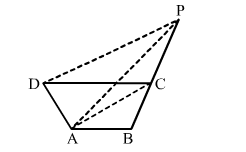In the adjoining figure, ABCD is a quadrilateral. A line through D, parallel to AC, meets BC produced in P.
Question:
In the adjoining figure, ABCD is a quadrilateral. A line through D, parallel to AC, meets BC produced in P. Prove that ar(∆ABP) = ar(quad. ABCD).

Solution:
We have:
ar(quad. ABCD) = ar(∆ACD) + ar(∆ABC)
ar(∆ABP) = ar(∆ACP) + ar(∆ABC)
∆ACD and ∆ACP are on the same base and between the same parallels AC and DP.
∴ ar(∆ACD) = ar(∆ ACP)
By adding ar(∆ABC) on both sides, we get:
ar(∆ACD) + ar(∆ABC) = ar(∆ACP) + ar(∆ABC)
⇒ ar (quad. ABCD) = ar(∆ABP)
Hence, proved.
Click here to get exam-ready with eSaral
For making your preparation journey smoother of JEE, NEET and Class 8 to 10, grab our app now.
